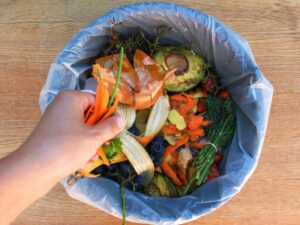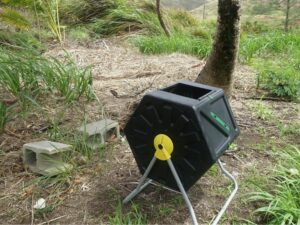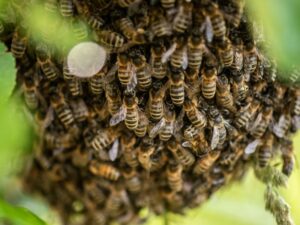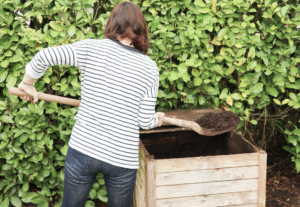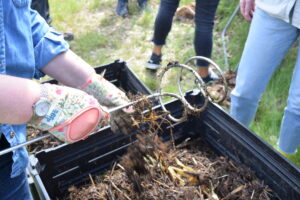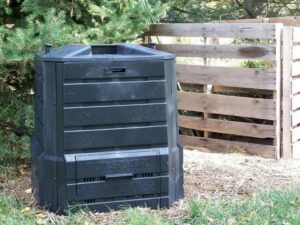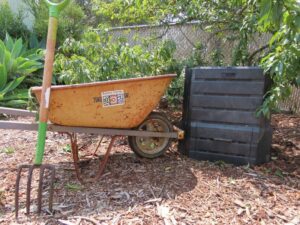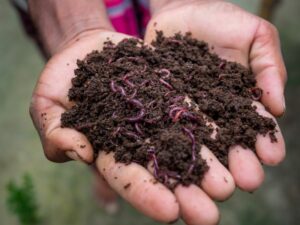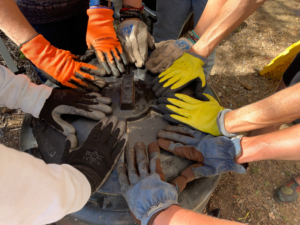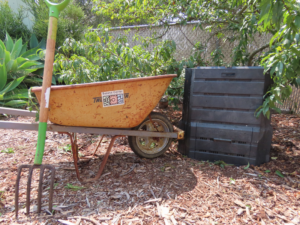Traditional compost
Climate Solutions: Save Water This Summer With Compost!
In Southern California, it is critical that we conserve water. A great way to tackle the water challenge is to incorporate compost into your summer garden and landscape. In addition to providing valuable nutrients, compost has been proven to increase soil’s water retention capacity. Here are a couple of ways to incorporate compost into your garden…
Read MoreHow Do Tumbler Compost Bins Work?
Tumblers are composting bins that are manually flipped, spun, rolled or crank-turned for aeration, depending on the style. These bins do not require turning with a pitchfork or auger, instead, the entire compost bin is turned for aeration. There are several variations on this theme. Spinning Tumbler This tumbler is spun around a central axis.…
Read MoreClimate Solutions: How to Manage Bee Swarms in Your Compost Bin
What Should You Do First? Many of us know that bees serve a vital role in the environment as pollinators, and that their populations have seen a concerning decline in recent years. However, it can still be alarming when a swarm of honeybees chooses to land around our home– including the inside of a compost…
Read MoreClimate Solutions: Can I convert a garbage can into a compost bin?
Yes, it is a great solution when a compost pile is just not feasible because of small yards or sensitive neighbors. Here’s a cheap and easy way to convert one of your garbage cans into a compost bin. Materials: – 30+ gallon plastic garbage can, with locking lid (optional: bungee cords to hold the lid…
Read MoreClimate Solutions: Aerators? What are those for?
Too lazy to turn your compost bin? Is it not easy to turn, or smells bad? If you answered yes to any of these questions, an aerator could be the right tool for you! Aeration (or the addition of air) is a very important ingredient in your compost pile. The microbes breaking down all the…
Read MoreCompost Bin Discounts and Vouchers
Looking to start composting at home? Many jurisdictions throughout the San Diego region offer discount programs for their residents. Your eligibility for discounted bins will depend on what jurisdiction you live in. It is important to check your exact address, because you may not necessarily live in the city listed in your address, e.g. a Vista address…
Read MoreFrom the Rotline: Where should I position my compost bin?
There are several things to keep in mind when choosing a location for your compost bin. Sun or shade? A worm bin is best placed in the shade. Worms do not fare well in hot temperatures or during a deluge of water during a rainstorm. By placing them in the shade, they will be more…
Read MoreCompost: It’s Alive!
The physical and chemical conditions in a compost heap seem logical if you think about what compost really is: an enormous pile of food for billions of minute organisms. These microorganisms have certain chemical requirements, including carbon for energy, nitrogen to build proteins, and oxygen for respiration. The most numerous organisms in a compost pile…
Read MoreLearnings from a Master Composter Course
These observations were originally shared by Kaitlin Mitchell of Rutabega Education and have been edited for cohesiveness. Solana Center’s Master Composter courses are a unique opportunity to gain a more in-depth understanding of the art and science of the composting process and empower participants to share this knowledge and passion with others. One participant in…
Read MoreFrom the Rotline: How Long Until My Compost Is Ready To Use?
Rotline Question: How long will it take until my compost is ready to be used? Answer: The timeline for composting depends on a number of factors. There are three basic approaches to composting which can be mixed and matched based on resources available and the composter’s goals. They are passive composting, active composting, and hot…
Read More
